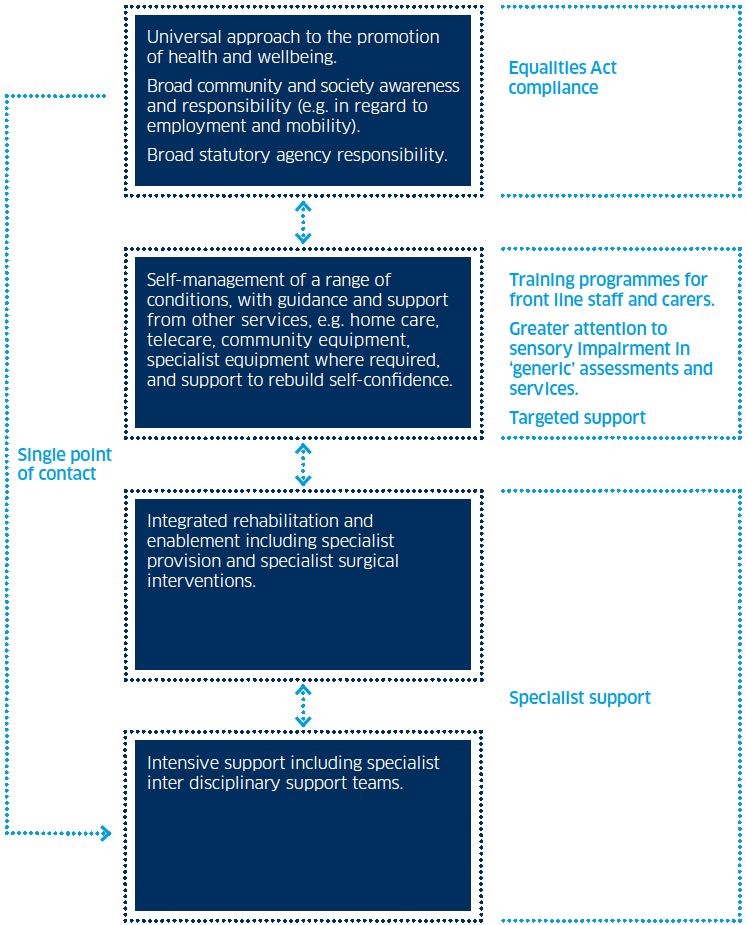See Hear
A strategic framework for meeting the needs of people with a sensory impairment in Scotland
6. National policies and practice expectations
6.1. The Scottish Human Rights Commission has identified Human Dignity and Care, and Human Rights in Healthcare as being amongst its key priorities, and a wide range of Scottish Government policies and guidelines have emerged over the last few years that have addressed a variety of issues across the health and social care agenda in relation to children and adults. These have all sought to focus on changing outcomes for service users.
6.2. It is recognised that increased need in the context of diminishing resources can only be met through the introduction of different ways of responding to need, commissioning and delivering support. While none of these policies and initiatives specifically relates to sensory impairment, they all have relevance to people with a sensory impairment.
6.3. The emerging themes include:
- A strong emphasis on an outcome focused approach that places the person at the centre, believing that the active engagement of the service user and their families and carers is the best means of ensuring effective outcomes in the planning and delivery of care;
- An acceptance of the importance of a redirection of resource towards more targeted preventative strategies that promote healthy lifestyles and the provision of information and advice to assist with this, both in general terms and also in relation
to specific conditions; - Early diagnosis and intervention (assisted by screening programmes) and the provision of information, emotional support and signposting to people and their parents/carers around the time of diagnosis;
- The need to facilitate greater flexibility in the support provided to people. This should be underpinned by greater choice and control for individuals, coupled with an emphasis on facilitating informed choice through good quality information and advice;
- The promotion of greater support to people to assist them to manage their own lives, particularly with regard to long term conditions. This should be done in a way that maximises independence and self-care, with appropriate support and guidance as required, and promotes the development of community capacity to support local responses to identified needs;
- Clear care pathways across a range of conditions that encourage and guide the individual through their engagement with assessment processes and service provision, and support them in managing their own conditions;
- Targeted support to people at time of transitions;
- The need to ensure effective and efficient joined up working across the public, third and independent sectors, with a drive to minimize duplication and encourage the sharing of information across and within agencies;
- Effective partnership approaches with service users and parents/carers;
- A skilled, sustainable and well-trained and supported workforce across all levels and agencies;
- A robust but proportionate means of measuring performance that concentrates on beneficial outcomes for service users and carers.
6.4. The above points all apply to people with a sensory impairment and represent the essential principles that should guide the development of services.
6.5. A number of national developments help to support these themes, and have implications for people with a sensory impairment. These include Self Directed Support, Reshaping Care for Older people (with funding from the Change Fund), the Early Years Collaborative, the revision of the National Care Standards, the implementation of the Carers and Young Carers Strategy, the Children and Young People (Scotland) Bill, and the Doran review.
6.6. Linked to these policies and expectations is the recognition that there is a hierarchy of need that requires a different type of response depending on the level of need. This is reflected in relation to sensory impairment in the diagram below.[12]
6.7. An individual may move between these levels over time, and it is the task of services to ensure that an appropriate response is available, in the context that at all times the emphasis should be on supporting the individual to obtain and retain maximum independence consistent with their safety and wellbeing. This can be enhanced by the effective strategic procurement and provision of appropriate community equipment that promotes independence and can link to the developing use of telehealth and telecare.

Contact
Email: Alan Nicholson
There is a problem
Thanks for your feedback